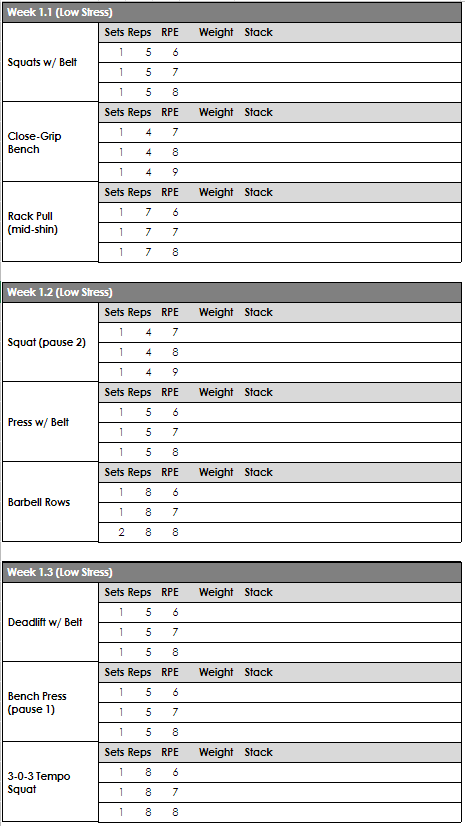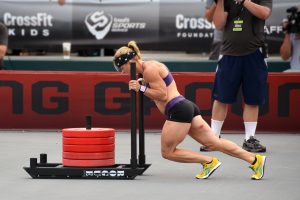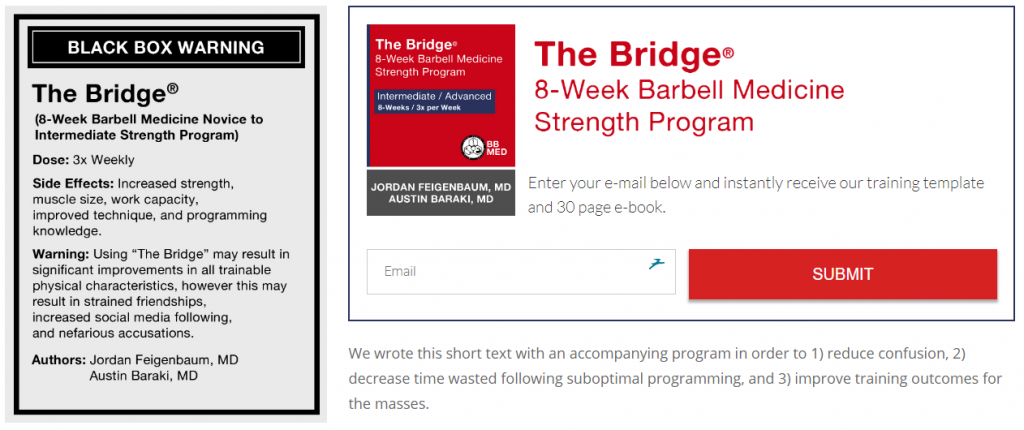When I asked for video content requests about two weeks ago, the number one request, by far, was more program reviews. The program that topped all the review requests was “The Bridge” by Jordan Feigenbaum of Barbell Medicine. While this program isn’t strictly a powerlifting program, and isn’t even intended for powerlifters, I don’t want to let the PTW fan base down without discussing it. Because it isn’t a powerlifting program, I don’t think it makes a great deal of sense to break the program down block by block, week by week, set by set, etc. Instead, we’re going to focus on what we, as powerlifters, can learn here.
Please, get your copy of The Bridge so you have a reference for what we’re talking about here.
If you’d rather watch than read:
Program Background Information
The Bridge was intended to be run after someone has finished the Starting Strength Linear Progression (SSLP). As the name implies, the program attempts to act as a bridge between novice linear progression and “true” intermediate programming. The authors, Jordan Feigenbaum and Austin Baraki, were (past tense) among the longest tenured Starting Strength Coaches. They have as much hands-on experience with coaching the Starting Strength system as almost anyone on the entire planet. As such, they’re intimately familiar with the problems an SS trainee faces after completing the novice program. With that said, let’s get into the big differences between the “style” of The Bridge and the SSLP.
Introduction of RPE
As I’ve discussed at length on this site, the introduction of autoregulation can massively benefit trainees who are of the right advancement because it allows us to account for fluctuations in readiness. With RPE training, “bad days” don’t mean missed reps and “good days” means you can take advantage of how strong you are on that particular day. You’re not limited to a predetermined, set progression and you basically take what your body gives you. For more about autoregulation, read our article on the subject.

Week 1 of The Bridge. As you can see, plenty of RPE work.
There is only one problem with this great addition: the SSLP does not prepare trainees for RPE style programming. Unlike the novice programs in ProgrammingToWin which make use of rep ranges and encourage people to try and record RPE after every set, the Starting Strength philosophy actively opposes the use of RPE. In fact, they’ve even published articles on their site suggesting that intermediate and advanced lifters are better off without RPE. You can see how this might represent a huge issue for people just finishing that program.
In my short time looking over the Starting Strength forums, most trainees coming off of the SSLP program are afraid that they cannot rate RPEs correctly or, worse yet, they don’t actually believe in RPEs whatsoever; they don’t believe people can actually rate RPEs correctly. I’m not kidding. This attitude isn’t surprising because, of course, you’re going to listen to the people that helped get you started in something.
However, unlike Rippetoe and many (most/all) of the Starting Strength Coaches, Dr. Feigenbaum has a Top 20 Total All-Time in his respective weight class, which points to the fact that this isn’t just theoretical for him:
Dr. Barkai and Dr. Feigenbaum have coached many national level IPF lifters. This experience has apparently taught them that RPE training is highly effective so it isn’t shocking to find that their programs are autoregulated. The current literature surrounding the effectiveness of autoregulation in strength training is only growing stronger and the concept has already proven itself among actual competitors. This is one reason you should be very wary of using traditional 3×5/5×5 novice programs if your goal is to someday become a competitive powerlifter. You want to start learning RPE as soon as possible. Again, this is why all the ProgrammingToWin novice programs include RPE style training.
Exercise Selection
Another change from the standard Starting Strength philosophy in both novice and intermediate programming that you’ll find in The Bridge has to do with exercise selection. Namely, there are a TON more variations. In the SSLP, you only use five exercises. In the SS intermediate program, you MIGHT use slight variations of those five main barbell exercises. That is it. Not so in The Bridge. There are multiple variations of every single lift throughout the program.
I hate to belabor the same point, but this represents a large step-up in complexity versus the SSLP. Sure, I think these additions are valuable and useful in many cases, but I do think there is a bit too much variety introduced too quickly. To go from never doing anything except squats, benches, deadlifts, presses, and power cleans to having 3-4 variations of each lift on your program is a pretty drastic change.
Many Starting Strength trainees feel the same way. They look at this program and it is intimidating because it is just SO different than the SSLP. To me, this is less a criticism of The Bridge and more of a criticism of traditional novice programming. All that said, I do agree that the variety is just a little too high for someone who just finished the SSLP. Keep in mind most people fresh off of finishing up novice program have far less than one year of training experience. In ProgrammingToWin, you’ll see that I increase variety and exercise selection in literally each and every single phase of novice programming AND intermediate programming. This slow introduction of new movements is less overwhelming for late-stage novice and/or newly intermediate trainees. When you’ve been introducing only 2-3 exercises per phase of training, there is plenty of time to get used to them and get used to new things being introduced in general. When you go from SSLP, which never introduces ANYTHING new, to suddenly having a list of 10+ exercises to perform throughout a block, many people are going to have trouble buying-in.
While this is only a minor criticism, I do think there is a bit too much variety in The Bridge considering the target audience.
Cardio, HIIT, and Work Capacity
The absolute best changes The Bridge brings to the table all have to do with increasing work capacity. Very briefly, work capacity is the amount of training volume you can productively handle. In other words, to quote Greg Nuckols, the amount of work you can do, recover from, and adapt positively to is your current work capacity.
Most novice programs are completely bereft of any attempt to improve work capacity in the long run. You may question why something like this even matters. Well, to give you the short version, long term progress depends on muscular hypertrophy. There are only so many improvements you can make to your technique, you can only get so good at using your equipment, and neural efficiency only improves so much. Once you’ve begun to tap those sources of strength gains, you have to rely on bigger muscles producing more contractile force to lift heavier weights. And what is the primary driver of muscle hypertrophy? TRAINING VOLUME!
To keep progressing over time, you must progressively use more and more training volume. In order for this to happen, you must challenge your current work capacity limitations to spur adaptations that will allow for more work. This is primarily done, as I’ve already mentioned, by slowly increasing training volume throughout a training career. However, cardio and interval training can also be excellent assets to this aim. While it is weird to think of cardio as “training volume”, it still is. Having some sort of aerobic base is going to allow for greater barbell training volume in the long run.
For this reason, multiple cardio and/or HIIT sessions are included in The Bridge. In fact, this is the exact same reason I’ve included cardio and HIIT in the ProgrammingToWin novice programs! I want to help develop work capacity from Day One. The reason why this is so key in The Bridge is that you MUST increase training volume as a trainee progresses (as we’ve already covered). If work capacity is never addressed, and it never is in the SSLP, you run into a scenario where you can’t actually recover from the training volumes that would be necessary to spur further progress. Basically, you’re stuck. Your only choice in this scenario is to take a step back from the heavier weights and start using programming aimed explicitly at improving work capacity. Rather than run into this issue somewhere down the line, I’d highly recommend just following programming that aims to develop work capacity from the very beginning. Again, this is why you’ll find that every single phase of ProgrammingToWin introduces slightly more volume and every single phase has some form of cardio or HIIT.

Prowler pushes are good for the soul. And work capacity development. credit: DrJohnRusin.com
The Fatal Flaw with The Bridge
Man, this is really hard for me to say because Jordan is one of my favorite guys in the strength and conditioning world, and I’ve never seen him be anything but super nice to everyone; however, I really don’t like The Bridge as a “bridge” between SSLP and more complex intermediate training. However, I do LOVE The Bridge as a “bridge” for early intermediate trainees to transition into more complex intermediate programming. The problem with The Bridge is that it is attached to the SSLP. Now that Dr. Feigenbaum and Dr. Baraki have split from Starting Strength and are no longer affiliated with the brand, I suspect we might see a Barbell Medicine novice program some day.
That would simply make far more sense. The SSLP is just too different both structurally and philosophically from the type of autoregulated, relatively high exercise variety training that is found in The Bridge. The Bridge has to fix all of these problems that SSLP trainees have and for what reason? If you have to patch up the holes in a sinking boat, well, I wish you the best of luck. However, wouldn’t it better to arrive on the shores of intermediate territory in a vessel without holes? Instead of doing SSLP, find yourself a novice program that already concerns itself with increases in work capacity, learning to use RPEs, and occasionally introduces new, useful exercises. In fact, just as an example, The Bridge would be an EXCELLENT program to run after finishing up PIP1 from ProgrammingToWin.
Overall, I think The Bridge great program. I just don’t think it is a great program to run after the SSLP. It is just too different.

Like this Article? Subscribe to our Newsletter!
If you liked this articled, and you want instant updates whenever we put out new content, including exclusive subscriber articles and videos, sign up to our Newsletter!
Questions? Comments?
For all business and personal coaching services related inqueries, please contact me: